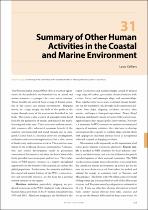JavaScript is disabled for your browser. Some features of this site may not work without it.
- ResearchSpace
- →
- Research Publications/Outputs
- →
- Book Chapters
- →
- View Item
| dc.contributor.author |
Celliers, Louis

|
|
| dc.date.accessioned | 2017-06-07T07:05:11Z | |
| dc.date.available | 2017-06-07T07:05:11Z | |
| dc.date.issued | 2015 | |
| dc.identifier.citation | Celliers, L. 2015. Summary of other human activities in the coastal and marine environment. In: UNEP-Nairobi Convention and WIOMSA. 2015. The Regional State of the Coast Report: Western Indian Ocean. UNEP and WIOMSA, Nairobi, Kenya | en_US |
| dc.identifier.uri | http://www.unep.org/nairobiconvention/sites/unep.org.nairobiconvention/files/rsocr_final.pdf | |
| dc.identifier.uri | http://hdl.handle.net/10204/9144 | |
| dc.description | Chapter in: UNEP-Nairobi Convention and WIOMSA. 2015. The Regional State of the Coast Report: Western Indian Ocean. UNEP and WIOMSA, Nairobi, Kenya | en_US |
| dc.description.abstract | The Western Indian Ocean (WIO) offers a wealth of opportunity for the profitable and beneficial use of coastal and marine resources – a prospect for a true ocean economy. These benefits are derived from a range of human activities in the coastal and marine environment. Shipping moves, by a large margin, the bulk of the goods to the region, through many of the ecosystems described in this book. The region is also a source of, amongst others, fossil fuels for the generation of energy, and minerals for manufacturing and other uses. These extractive and non-renewable resources offer substantial economic benefit, if the negative environmental and social impacts can be mitigated. Coastal land as a resource allows for development, settlement and recreation opportunities, but is also a source of biodiversity and ecosystem services. These services contribute to the wellbeing of coastal communities. Urbanisation and coastal development result in permanent conversion of this resource and often the loss of most of the freely provided ecosystem goods and services. The exploitation of WIO genetic resources is a largely unexplored opportunity for the benefit of the regional and indeed the global population. Furthermore, the attractive and desirable coastal and marine habitats of the WIO, a non-extractive and renewable resource, are the basis for a growing tourism industry in the region. | en_US |
| dc.language.iso | en | en_US |
| dc.publisher | UNEP-Nairobi Convention and WIOMSA | en_US |
| dc.relation.ispartofseries | Worklist;18423 | |
| dc.subject | Western Indian Ocean | en_US |
| dc.subject | WIO | en_US |
| dc.subject | Coastal resources | en_US |
| dc.subject | Marine resources | en_US |
| dc.title | Summary of other human activities in the coastal and marine environment | en_US |
| dc.type | Book Chapter | en_US |
| dc.identifier.apacitation | Celliers, L. (2015). Summary of other human activities in the coastal and marine environment., <i>Worklist;18423</i> UNEP-Nairobi Convention and WIOMSA. http://hdl.handle.net/10204/9144 | en_ZA |
| dc.identifier.chicagocitation | Celliers, Louis. "Summary of other human activities in the coastal and marine environment" In <i>WORKLIST;18423</i>, n.p.: UNEP-Nairobi Convention and WIOMSA. 2015. http://hdl.handle.net/10204/9144. | en_ZA |
| dc.identifier.vancouvercitation | Celliers L. Summary of other human activities in the coastal and marine environment.. Worklist;18423. [place unknown]: UNEP-Nairobi Convention and WIOMSA; 2015. [cited yyyy month dd]. http://hdl.handle.net/10204/9144. | en_ZA |
| dc.identifier.ris | TY - Book Chapter AU - Celliers, Louis AB - The Western Indian Ocean (WIO) offers a wealth of opportunity for the profitable and beneficial use of coastal and marine resources – a prospect for a true ocean economy. These benefits are derived from a range of human activities in the coastal and marine environment. Shipping moves, by a large margin, the bulk of the goods to the region, through many of the ecosystems described in this book. The region is also a source of, amongst others, fossil fuels for the generation of energy, and minerals for manufacturing and other uses. These extractive and non-renewable resources offer substantial economic benefit, if the negative environmental and social impacts can be mitigated. Coastal land as a resource allows for development, settlement and recreation opportunities, but is also a source of biodiversity and ecosystem services. These services contribute to the wellbeing of coastal communities. Urbanisation and coastal development result in permanent conversion of this resource and often the loss of most of the freely provided ecosystem goods and services. The exploitation of WIO genetic resources is a largely unexplored opportunity for the benefit of the regional and indeed the global population. Furthermore, the attractive and desirable coastal and marine habitats of the WIO, a non-extractive and renewable resource, are the basis for a growing tourism industry in the region. DA - 2015 DB - ResearchSpace DP - CSIR KW - Western Indian Ocean KW - WIO KW - Coastal resources KW - Marine resources LK - https://researchspace.csir.co.za PY - 2015 T1 - Summary of other human activities in the coastal and marine environment TI - Summary of other human activities in the coastal and marine environment UR - http://hdl.handle.net/10204/9144 ER - | en_ZA |






